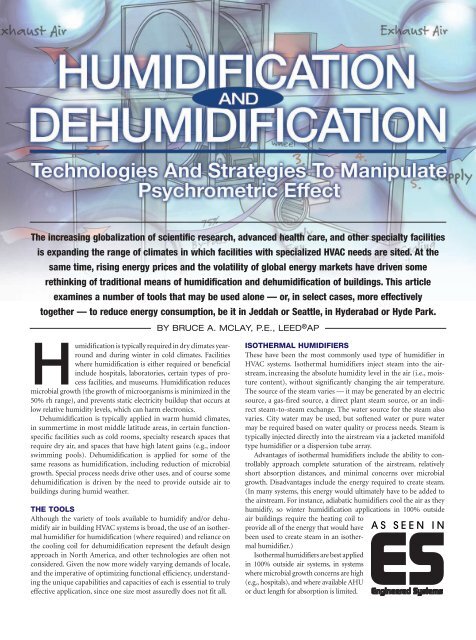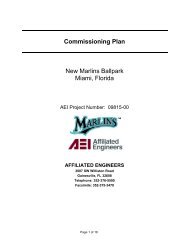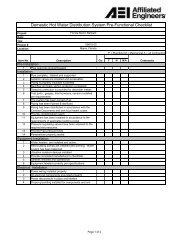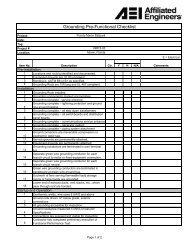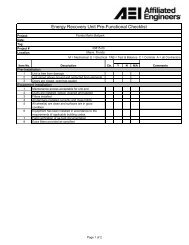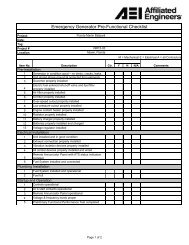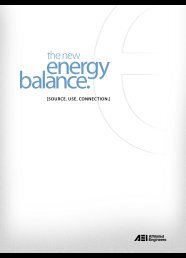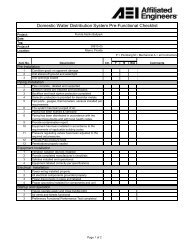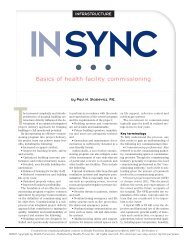Humidification - Affiliated Engineers, Inc.
Humidification - Affiliated Engineers, Inc.
Humidification - Affiliated Engineers, Inc.
Create successful ePaper yourself
Turn your PDF publications into a flip-book with our unique Google optimized e-Paper software.
The increasing globalization of scientific research, advanced health care, and other specialty facilities<br />
is expanding the range of climates in which facilities with specialized HVAC needs are sited. At the<br />
same time, rising energy prices and the volatility of global energy markets have driven some<br />
rethinking of traditional means of humidification and dehumidification of buildings. This article<br />
examines a number of tools that may be used alone — or, in select cases, more effectively<br />
together — to reduce energy consumption, be it in Jeddah or Seattle, in Hyderabad or Hyde Park.<br />
<strong>Humidification</strong> is typically required in dry climates yearround<br />
and during winter in cold climates. Facilities<br />
where humidification is either required or beneficial<br />
include hospitals, laboratories, certain types of process<br />
facilities, and museums. <strong>Humidification</strong> reduces<br />
microbial growth (the growth of microorganisms is minimized in the<br />
50% rh range), and prevents static electricity buildup that occurs at<br />
low relative humidity levels, which can harm electronics.<br />
Dehumidification is typically applied in warm humid climates,<br />
in summertime in most middle latitude areas, in certain functionspecific<br />
facilities such as cold rooms, specialty research spaces that<br />
require dry air, and spaces that have high latent gains (e.g., indoor<br />
swimming pools). Dehumidification is applied for some of the<br />
same reasons as humidification, including reduction of microbial<br />
growth. Special process needs drive other uses, and of course some<br />
dehumidification is driven by the need to provide outside air to<br />
buildings during humid weather.<br />
THE TOOLS<br />
Although the variety of tools available to humidify and/or dehumidify<br />
air in building HVAC systems is broad, the use of an isothermal<br />
humidifier for humidification (where required) and reliance on<br />
the cooling coil for dehumidification represent the default design<br />
approach in North America, and other technologies are often not<br />
considered. Given the now more widely varying demands of locale,<br />
and the imperative of optimizing functional efficiency, understanding<br />
the unique capabilities and capacities of each is essential to truly<br />
effective application, since one size most assuredly does not fit all.<br />
BY BRUCE A. MCLAY, P.E., LEED ® AP<br />
ISOTHERMAL HUMIDIFIERS<br />
These have been the most commonly used type of humidifier in<br />
HVAC systems. Isothermal humidifiers inject steam into the airstream,<br />
increasing the absolute humidity level in the air (i.e., moisture<br />
content), without significantly changing the air temperature.<br />
The source of the steam varies — it may be generated by an electric<br />
source, a gas-fired source, a direct plant steam source, or an indirect<br />
steam-to-steam exchange. The water source for the steam also<br />
varies. City water may be used, but softened water or pure water<br />
may be required based on water quality or process needs. Steam is<br />
typically injected directly into the airstream via a jacketed manifold<br />
type humidifier or a dispersion tube array.<br />
Advantages of isothermal humidifiers include the ability to controllably<br />
approach complete saturation of the airstream, relatively<br />
short absorption distances, and minimal concerns over microbial<br />
growth. Disadvantages include the energy required to create steam.<br />
(In many systems, this energy would ultimately have to be added to<br />
the airstream. For instance, adiabatic humidifiers cool the air as they<br />
humidify, so winter humidification applications in 100% outside<br />
air buildings require the heating coil to<br />
provide all of the energy that would have AS SEEN IN<br />
been used to create steam in an isothermal<br />
humidifier.)<br />
Isothermal humidifiers are best applied<br />
in 100% outside air systems, in systems<br />
where microbial growth concerns are high<br />
(e.g., hospitals), and where available AHU<br />
or duct length for absorption is limited.
ADIABATIC HUMIDIFIERS<br />
Adiabatic humidifiers are available in several<br />
forms. The category includes wetted pad type<br />
humidifiers, spray nozzle humidifiers (which<br />
may use either pressurized water or water<br />
and compressed air for atomization), and<br />
ultrasonic humidifiers. Adiabatic humidifiers<br />
evaporate moisture into the air by presenting<br />
a large water surface area to the airstream.<br />
This is achieved by either wetting a medium<br />
with a large surface area (wetted pad type) or<br />
by atomizing the water into very small droplets<br />
(spray nozzles or ultrasonic). The water<br />
source is often city water, although fouling<br />
may be reduced through the use of either<br />
softened or pure water. Ultrasonic humidifiers<br />
require pure water.<br />
Advantages of adiabatic humidifiers<br />
include the low energy required to humidify<br />
the air (which is typically negated in winter<br />
100% outside air applications as noted<br />
above) and the associated cooling effect,<br />
which can be used to great advantage in<br />
warm dry climates. Disadvantages include<br />
a somewhat increased microbial growth<br />
risk due to the ambient temperature water<br />
source, particularly in the wetted media<br />
type where water is essentially stagnant.<br />
Absorption distances also tend to be longer<br />
(for spray type) and approach to full saturation<br />
is generally more difficult.<br />
Adiabatic humidifiers are best applied in<br />
dry climates, particularly if humidification<br />
is required during cooling season, and in<br />
systems with airside economizers, which<br />
can also benefit seasonally from the reduced<br />
energy use of adiabatic humidifiers.<br />
SOLID DESICCANT DEHUMIDIFIERS<br />
Solid desiccant dehumidifiers usually take<br />
the form of desiccant wheels, rotary heat<br />
exchangers either coated or impregnated<br />
with a desiccant material (typically silica<br />
gel or lithium chloride). Desiccant wheels<br />
are designed to remove moisture from the<br />
airstream, and operate nearly adiabatically,<br />
dependent on the heat of sorption of the<br />
desiccant and the mass of the matrix used to<br />
present the desiccant to the air. The path followed<br />
by the supply air on a psychrometric<br />
chart is nearly the opposite of the adiabatic<br />
humidifier, but the path tends to be slightly<br />
flatter due to the effects mentioned above.<br />
Desiccant wheels are divided into a<br />
process side and a regeneration side. The<br />
process (supply) side air is dried by the<br />
desiccant material, while on the regeneration<br />
side, another airstream is preheated<br />
and runs in counterflow through<br />
FIGURE 1. Typical panel-type isothermal humidifier and associated psychrometric path.<br />
(AEI Illustration.)<br />
FIGURE 2. Typical wetted-media-type adiabatic humidifer and associated psychrometric<br />
path. (AEI Illustration.)<br />
FIGURE 3. Typical desiccant wheel process and regeneration sides and associated psychrometric<br />
paths. (AEI Illustration.)<br />
FIGURE 4. Typical enthalpy wheel and associated outside air and exhuast air psychrometric<br />
paths. (AEI Illustration.)
<strong>Humidification</strong> and Dehumidification<br />
FIGURE 5. Typical cooling coil and associated psychrometric path. (AEI Illustration.)<br />
FIGURE 6. Dehumidification section of Seattle Biotech AHU and associated psychrometric<br />
path. (AEI Illustration.)<br />
FIGURE 7. The Pennington Cycle, shown diagrammatically, and on the psychrometric<br />
chart. (AEI Illustration.)<br />
the opposite side of the desiccant wheel,<br />
driving moisture back out of the wheel.<br />
The potential for drying of the supply<br />
side is determined by the relative humidity<br />
of the regeneration air. The hotter the<br />
regeneration air is heated, the lower the<br />
relative humidity and the greater the drying<br />
potential in the supply side. Outside<br />
air and building exhaust air are the most<br />
common sources of regeneration air. The<br />
heat source for regeneration is typically<br />
hot water, ideally from a waste source.<br />
Advantages of desiccant dehumidifiers<br />
include the ability to dry air to very<br />
low dewpoints. The ability to dry using<br />
a heat source may also be an advantage,<br />
particularly where a waste heat source is<br />
available. Disadvantages include first cost<br />
and elimination of the sensible heat that<br />
must be removed in most cases (typically<br />
through the use of a supplemental rotary<br />
heat exchanger).<br />
Desiccant wheels are best applied when<br />
required dewpoint temperature approaches<br />
32°F, making it impractical to use cooling<br />
coils due to coil frost issues; when the<br />
cost of heat is low relative to electricity; or<br />
where very high levels of moisture reduction<br />
are necessary.<br />
LIQUID DESICCANT DEHUMIDIFIERS<br />
Liquid desiccant dehumidifiers operate in<br />
manner similar to solid desiccants but use a<br />
spray tower rather than a wheel to present<br />
the desiccant to the airstream. The process<br />
side air runs in counterflow with a dry<br />
desiccant spray (usually lithium chloride<br />
or lithium bromide), the desiccant is then<br />
regenerated by a heated airstream in a<br />
regeneration side spray tower.<br />
Liquid desiccant systems tend to be<br />
more expensive than solid desiccants but<br />
offer the benefit of enhanced microbial<br />
decontamination due to the bacteriacidal<br />
and virucidal nature of lithium chloride.<br />
Advantages and disadvantages are similar<br />
to solid desiccant wheels. Liquid desiccants<br />
offer the advantage over solid wheels of<br />
slightly better isolation of supply and exhaust<br />
airstreams, since wheel carryover is not possible.<br />
Applications are also similar, but liquid<br />
desiccants may offer benefits where greater<br />
microbial decontamination is required or<br />
where the liquid desiccant’s capabilities closely<br />
match process requirements.<br />
ENTHALPY WHEELS<br />
Enthalpy wheels are similar in nature to<br />
desiccant wheels — both are rotary heat<br />
exchangers either coated or impregnated<br />
with a desiccant material — but differ in their<br />
focus. While desiccant wheels manipulate the<br />
regeneration side airstream to achieve deep<br />
drying, enthalpy wheels focus on extraction<br />
of the available moisture, or lack thereof,<br />
in the building exhaust airstream. Enthalpy<br />
wheels are also intended to operate as heat<br />
exchangers. Accordingly, the sensible heat<br />
transfer capability of enthalpy wheels is
high, whereas the heat transfer capability of<br />
desiccant wheels is low, since the transfer of<br />
sensible heat from the hot regeneration side<br />
air is an unwanted side effect.<br />
Advantages of enthalpy wheels include<br />
the ability to simultaneously transfer both<br />
heat and moisture.<br />
Enthalpy wheels are best applied in high<br />
outside air percentage humidified buildings<br />
in cold climates, where recovery of<br />
the energy invested in both heating and<br />
humidification is possible, and in high<br />
outside air percentage very humid climates<br />
where enthalpy wheels can recover both<br />
cooling and lack of dehumidification from<br />
the outgoing air.<br />
COOLING COILS<br />
Although dehumidification is typically not<br />
the primary purpose of a cooling coil, cooling<br />
coils act as summer dehumidifiers in<br />
most commercial buildings by limiting the<br />
dewpoint of the supply air to no more than<br />
the discharge air temperature of the air<br />
handling unit (typically 55°).<br />
Advantages of cooling coils include<br />
simplicity and familiarity. Disadvantages<br />
include inability to dehumidify easily at<br />
or below 32° and inability to handle large<br />
loads without multiple coils.<br />
Cooling coils are best applied where cooling<br />
loads are modest and where process<br />
requirements do not drive unusually low<br />
humidity.<br />
EXAMPLE 1<br />
The King Abdullah University of Science<br />
and Technology (KAUST) is sited in the<br />
high heat and humidity of Jeddah, in Saudi<br />
Arabia’s desert coastal climate. The requirement<br />
for 100% outside air in the laboratory<br />
facilities presented a real challenge given<br />
the design conditions. The logical approach<br />
of the enthalpy wheel (recommended by<br />
Gary Kuzma of HOK) can salvage a high<br />
percentage of the dehumidification and<br />
cooling that has been invested in the building<br />
exhaust air.<br />
As the psychrometric chart shows, the<br />
burden on a cooling coil acting alone in<br />
an attempt to cool and dehumidify the<br />
incoming outside air would be extreme.<br />
The enthalpy wheel recaptures a high percentage<br />
of the cooling and dehumidification<br />
already performed on the exhaust air,<br />
leaving the cooling coil with a much more<br />
modest and manageable load. The reduction<br />
in cooling load handled by the cooling<br />
coil is 64% compared to a cooling coil<br />
operating alone, and the effectiveness of the<br />
enthalpy wheel was 81.4% (e.g., the wheel is<br />
able to transfer 81.4% of the enthalpy difference<br />
between the supply and exhaust air<br />
from the exhaust to the supply).<br />
EXAMPLE 2<br />
This biotech research facility is located in<br />
the mild marine climate of Seattle. The<br />
laboratory facility included a process space<br />
with very specific temperature and humidity<br />
requirements. The conditions presented<br />
a challenge because the desired humidity<br />
was just low enough that subcooling by a<br />
cooling coil would be difficult.<br />
The solution was the use of a solid desiccant<br />
wheel to assist with moisture removal.<br />
Since the desiccant wheel’s ability to remove<br />
moisture was much greater that the required<br />
level of reduction, only a portion of the supply<br />
air was directed through the desiccant<br />
wheel. As seen on the psychrometric chart,<br />
by bypassing approximately 20% of the air<br />
the through a desiccant wheel, the total<br />
air absolute humidity was reduced from<br />
51 grains/lb to approximately 42 grains/lb<br />
by mixing 7-grain desiccated air with the<br />
bypassed 51-grain air.<br />
EXAMPLE 3<br />
While the tools discussed here are often used<br />
alone, they may also be used in combination<br />
to achieve a particular psychrometric<br />
effect or to take advantage of available<br />
resources. An example is the Pennington<br />
Cycle. The Pennington Cycle is a 100% outside<br />
air cycle that incorporates a desiccant<br />
wheel, a sensible heat exchanger wheel, and<br />
an adiabatic humidifier. Supply side air is<br />
first dehumidified, then cooled sensibly in<br />
the heat exchanger, and finally humidified<br />
(and cooled) adiabatically by the adiabatic<br />
humidifier (evaporative cooler).<br />
On the exhaust side, the air is first adiabatically<br />
humidified (and cooled) to enhance<br />
the cooling effect on the supply side air<br />
as the return passes the cool to the supply<br />
in the rotary heat exchanger. The exhaust<br />
air is then heated by a low grade heat<br />
source (often solar or waste heat), and dries<br />
(regenerates) the desiccant material.<br />
As the psychrometric chart shows, the combination<br />
of desiccation, sensible cooling,<br />
and adiabatic humidification of the supply<br />
air creates a circuitous path around the<br />
psychrometric chart, but the beginning and<br />
end points are very close to those that a<br />
cooling coil alone could have achieved.<br />
Ordinarily, this would seem to be an overly<br />
complex means to achieve cooling, but the<br />
cycle is intended to take advantage of waste<br />
heat (or solar heat) for cooling. By applying<br />
this particular series of components, waste<br />
heat is converted into cooling energy.<br />
CONCLUSION<br />
Best available technologies for humidification<br />
and dehumidification vary according<br />
to system type, climate, process requirements,<br />
energy use expectations, space availability,<br />
and contamination concerns. The<br />
needs of the system, the efficiency of the<br />
technology, and the cost of available energy<br />
sources must be considered as systems are<br />
selected.<br />
Some general conclusions:<br />
As reported elsewhere, adiabatic humidifiers<br />
may offer energy savings over isothermal<br />
humidifiers in systems with less than<br />
50% outside air.<br />
Enthalpy wheels offer great benefits for<br />
pre-conditioning of outside air in hot<br />
humid climates (and the same holds true<br />
for high outside air percentage-humidified<br />
buildings in cold climates).<br />
Desiccant wheels and liquid desiccant<br />
systems provide deep drying capability in<br />
applications that require air at dew points<br />
less than 42° to 45°.<br />
<strong>Humidification</strong> and dehumidification<br />
technologies can be used in series (or parallel)<br />
to achieve a net effect equivalent to<br />
other technologies, with potential energy<br />
savings benefits. ES<br />
McLay is a senior<br />
engineer and project<br />
manager with AEI/<br />
<strong>Affiliated</strong> <strong>Engineers</strong>,<br />
<strong>Inc</strong>., specializing in<br />
technically complex<br />
facilities.<br />
Reprinted from Engineered Systems Magazine © September 2009 P.O. Box 4270 Troy, MI 48099


